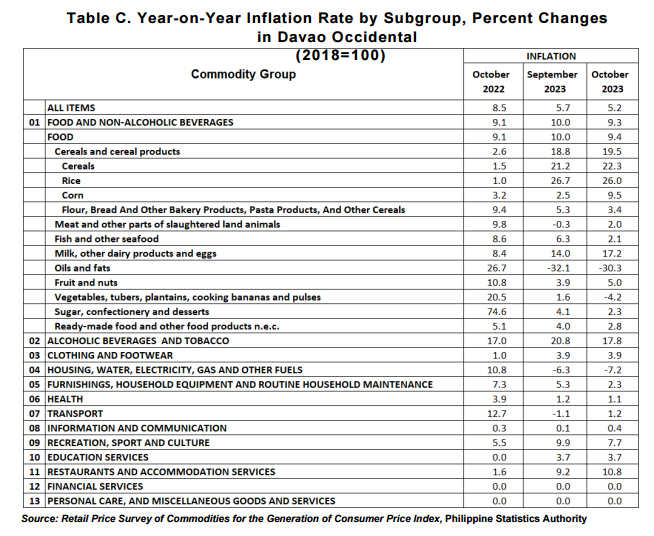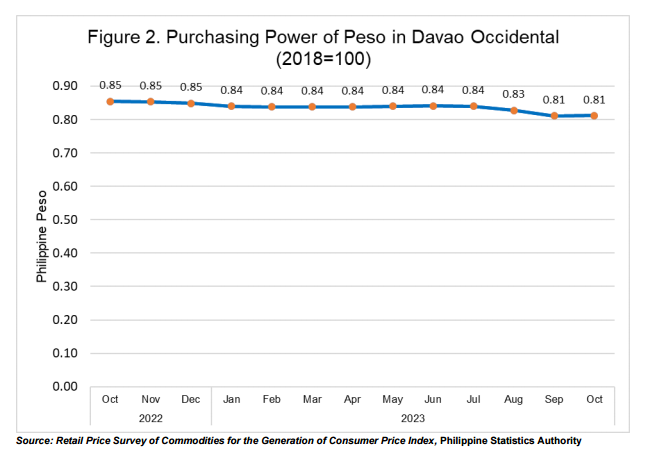

The Davao Occidental headline inflation or overall inflation declined to 5.2 percent in October 2023 from 5.7 percent in September 2023. This makes the provincial average inflation from January to October 2023 remained at 5.7 percent. In October 2022, the inflation rate was higher at 8.5 percent. (Table A and Figure 1)
The downtrend in the overall inflation in October 2023 was primarily brought about by the lower year on-year increase in the heavily-weighted food and non-alcoholic beverages at 9.3 percent during the month from 10.0 percent in the previous month. Alcoholic beverages and tobacco, with inflation rate of 17.8 percent during the month from 20.8 percent in the previous month, also contributed to the downtrend of the headline inflation.
In addition, lower annual inflation was noted in the indices of the following commodity groups during the month:
a. Recreation, sports and culture, 7.7 percent from 9.9 percent;
b. Furnishing, household equipment and routine, 2.3 percent from 5.3 percent;
c. Health, 1.1 percent from 1.2 percent; and
d. Housing, water, electricity, gas and other fuels, -7.2 percent from -6.3 percent.
In contrast, the following commodity groups showed higher inflation rates during the month:
a. Restaurants and accommodation services, 10.8 percent from 9.2 percent;
b. Information and communication, 0.4 percent from 0.1 percent; and
c. Transport, 1.2 percent from -1.1 percent.
On the other hand, education retained its inflation with the previous months at 3.7 percent. While the financial services and personal care, and miscellaneous goods and services remained at zero growth during the month. (Tables B)

The food inflation at the provincial level dropped to 9.4 percent in October 2023 from 10.0 percent in the previous month. In October 2022, the food inflation was lower at 9.1 percent.
The deceleration of food inflation in October 2023 was mainly brought about by the lower inflation for rice with inflation rate of 26.0 percent from 26.7 percent in September 2023. This was followed by flour, bread and other bakery products, pasta products, and other cereals with an inflation rate of 3.4 percent during the month from 5.3 percent in previous month. Another contributed to lower food inflation is slower annual increments of ready-made food and other food products n.e.c which is at 2.8 percent in October 2023 from 4.0 percent in the previous month, and sugar, confectionery, and desserts with 2.3 percent during the month from 4.1 percent in September 2023. In addition, fish and other seafood posted lower inflation from 6.3 percent previous month to 2.1 percent in October 2023. Also, vegetables, tubers, plantains, cooking bananas and pulses from 1.6 percent to -4.2 percent in October 2023. Meanwhile, compared with their previous month’s inflation rates, higher annual growth rates during the month were observed in the indices of the following;
a. Cereals and cereal products from 18.8 percent to 19.5 percent;
b. Milk, other dairy products, and eggs from 14.0 percent to 17.2 percent;
c. Fruits and nuts from 3.9 percent to 5.0 percent;
d. Meat and other parts of slaughtered land animals from -0.3 percent to 2.0 percent; and
e. Oils and fats from -32.1 percent to -30.3 percent. (Table C)



In addition, the October 2023 Purchasing Power of Peso (PPP) in Davao Occidental remained at 0.81. (Figure 2)
Technical Notes:
Consumer Price Index (CPI) - The CPI is an indicator of the change in the average retail prices of a fixed basket of goods and services commonly purchased by households relative to a base year.
Inflation Rate (IR) - The inflation rate is the annual rate of change, or the year-on-year change of the CPI expressed in percent. Inflation is interpreted in terms of declining purchasing power of money.
Headline Inflation - measures changes in the cost of living based on movements in the prices of a specified basket of major commodities. It refers to the annual rate of change or the year-on-year change in the Consumer Price Index (CPI).
Purchasing Power of the Peso (PPP) - The purchasing power of the peso shows how much the peso in the base period is worth in the current period. It is computed as the reciprocal of the CPI for the period under review multiplied by 100.
Approved for Release:
JESSIE A. MADULIN
Chief Statistical Specialist
